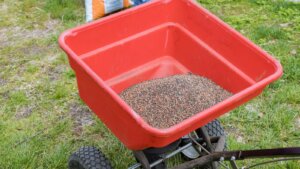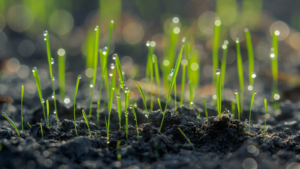Fertilizer application is an essential process in agriculture and gardening. The method of fertilizer application you choose can significantly impact your plants’ nutrient uptake and soil’s overall health. In this article, we will unearth the different methods of applying fertilizer and guide you on choosing the best method for your needs.
Understanding Fertilizer Application
Fertilizer application refers to the process of adding supplemental nutrients to the soil to enhance plant growth. The application method can vary depending on several factors, including the type of fertilizer, its form, and the specific needs of the plants and soil.
One popular method of fertilizer application is row application, where the fertilizer is applied in rows of crops. This method allows for direct application of the fertilizer close to the seed or plant, ensuring that the nutrients are readily available to the growing plants. This method is particularly effective for crops like sugarcane and maize, which are typically planted in widely spaced rows.
Another method is furrow application, where the fertilizer is placed at the bottom of a furrow or a narrow trench in the soil. This method, also known as plough sole placement, is often used in areas where the soil becomes quite dry up to a few inches below the soil surface during the growing season. Placing the fertilizer in the moist soil at the bottom of the furrow can make it more available to the growing plants during dry seasons.
Irrigation is another key factor in fertilizer application. Fertilizers like urea can be dissolved in irrigation water and applied to the soil through a method known as fertigation. This method allows for the use of water-soluble fertilizers and can be done through either open or closed irrigation systems, such as sprinkler or drip irrigation systems. This method allows for the efficient use of fertilizers, as it reduces nitrogen loss and ensures that the nutrients are evenly distributed in the soil.
The choice of method for fertilizer application can also depend on the amount of fertilizer to be applied and the time of application. For instance, band application refers to the method where a continuous band of fertilizer is applied on one or both sides of a seed or seedling. This method is often used when a large amount of fertilizer needs to be applied, and it is particularly effective for widely spaced crops.
Dry or Pelletized Application
Dry fertilizer, often in the form of pellets, is a common type of fertilizer that can be applied directly to the soil. This application method is particularly useful for soils having a heavy clay content, as the pellets can be placed at a depth where they can slowly release nutrients without getting washed away. The placement of fertilizers in this method often depends on the plants’ specific nutrient needs and the soil’s condition. For instance, anhydrous ammonia, a type of nitrogen fertilizer, should be applied at a certain depth to prevent it from escaping to the atmosphere.
Liquid Nutrient Application
Liquid fertilizer is another popular form of fertilizer that is often preferred for its ease of application and quick absorption rate. This fertilizer application method involves the use of liquid fertilizers, which can be applied in several ways. One common method is fertigation, where the fertilizer is dissolved in irrigation water and applied to the soil through either open or closed irrigation systems. This method ensures efficient use of fertilizers, as it allows for the nutrients to be evenly distributed in the soil. However, it’s important to note that applying liquid fertilizer requires careful handling to avoid over-fertilization and potential damage to young plants.
Soil Application
Soil application refers to the method of applying fertilizer directly to the soil. This method ensures that the nutrients are placed where the plants need them most – in the root zone. It is particularly effective for nutrients like nitrogen, which can be lost to the atmosphere if applied on the soil surface. The fertilizer is applied between rows of crops or around the plants, ensuring that the nutrients are readily available to the crop. This method can involve the use of manures and fertilizers, which can be applied by hand or using broadcasting methods for surface application.
In all these methods, the choice of application method often depends on the plants’ specific needs and the soil’s condition. The goal is to ensure that the nutrients are placed in the soil to promote root development and overall plant health.
Broadcasting or Top-Dress Application Method
Broadcasting, also known as top-dressing, is a method of fertilizer application where the fertilizer is applied uniformly over the entire field. This method is often used when the soil is highly deficient of nutrients, particularly nitrogenous fertilizers. Broadcasting can be done at the time of sowing or planting, or as a top dressing on a standing crop.
In the broadcasting method, the application of fertilizer is done either by hand or using a spreader, ensuring a uniform distribution over the entire field. This method is particularly effective for crops that are sown close together, as it allows the fertilizer to reach a larger number of plants. However, care must be taken to apply the fertilizer to the side of the row to avoid direct contact with the seeds or young plants, which could potentially cause damage.
Foliar Application
Foliar application refers to the spraying of fertilizer solution directly onto the leaves of plants. This method is often used for quick recovery from nutrient deficiencies and avoids fixation of nutrients in the soil. The fertilizer solution is typically applied using a sprayer, which can be either a simple hand-held device or a more complex system attached to a tractor or other vehicle.
In foliar application, the fertilizer solution is applied directly to the leaves of the plants, allowing for quick absorption and immediate availability of nutrients. This method is particularly effective for addressing nutrient deficiencies during the growing season, as it allows the plants to take up the nutrients they need quickly. However, care must be taken to ensure the fertilizer solution is sufficiently diluted to avoid damaging the plants.
Other Methods of Fertilizer Application
There are several other methods of fertilizer application that can be used depending on the specific needs of your plants and soil. These include deep placement, sub-soil placement, localized placement, and fertigation. Each of these methods has its own benefits and is used in specific scenarios to ensure efficient use of fertilizers.
For instance, deep placement refers to the placement of fertilizer at a depth in the soil where it will be most accessible to the roots of the plants. This method is often used in soils with a high clay content, where irrigation water or rainfall can easily leach nutrients away.
Sub-soil placement involves the application of fertilizer below the plough furrow, ensuring that the nutrients are placed close to the seed or plant roots. This method is particularly effective for crops like maize and sugarcane, which have deep root systems.
Localized placement involves the application of fertilizer in a small band or spot, often on one or both sides of the seed or plant. This method ensures that the nutrients are placed where they will be most readily available to the growing plants.
Finally, fertigation involves the application of water-soluble fertilizers through irrigation water, using either an open or closed irrigation system. This method allows for the efficient use of fertilizers, as it ensures that the nutrients are evenly distributed in the soil and readily available to the plants.
Ensuring a Flourishing Future: The Art of Selecting the Right Fertilizer Application Technique
Choosing the right method of fertilizer application is crucial for the health of your soil and plants. By understanding the different methods and their benefits, you can make an informed decision that will help your plants thrive. Remember, the best method of fertilizer application is the one that meets the specific needs of your plants and soil.
We hope this article has provided you with valuable insights into the different methods of fertilizer application. We’d love to hear from you if you have any questions, need further advice, or are interested in our services!
At Terra Lawn Care Specialists, we pride ourselves on our customer-first philosophy. Our knowledgeable staff gives each customer’s property the same attention they would to their own. We use and carry the top brands in the lawn care industry, ensuring that we bring only the finest products to work on your home.
You can reach out to us in the following ways:
- Give Us a Call: Reach us at (610) 275-2170. We’re always ready to answer your questions and provide you with the greenest, weed-free lawn at a reasonable price.
- Visit Our Office: We’re located at 3481 Germantown Pike, Collegeville, PA 19426. Feel free to drop by!
- Fill Out Our Online Form: Visit our Contact Us page and fill out the form. We’ll return your call or email within 48 hours.
At Terra Lawn Care Specialists, we believe in a customer-first philosophy. Whether you need an emergency cut, have a shrub emergency, or simply want to discuss your lawn care needs, we’re here to help. We look forward to helping you achieve a greener, healthier lawn



